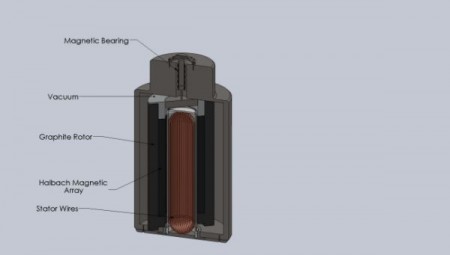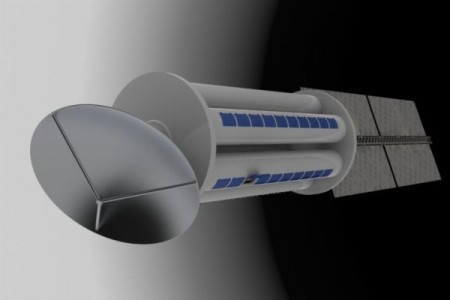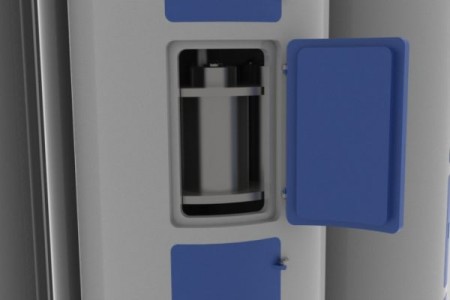Feb
7
A New Idea for the Electro Mechanical Battery
February 7, 2012 | 2 Comments
Carl Peart of New Mexico has a very different take on the electro mechanical battery (EMB) – solve the inherent problems of friction with air and bearings – by using them in orbital power stations. No air or gravity, only centrifugal forces for drag.
An EMB (a technical description of a flywheel) stores energy through spinning a composite flywheel with an electric motor that’s built in, driving the rotating mass to speed making the system into a battery. Then use the electricity by using the motor as a generator that slows the flywheel down. EMBs aren’t quite dead, the once widely admired Beacon Power flywheel builder that’s in bankruptcy has found a buyer that may put the intellectual property back to work and return a chunk of a federal loan to the taxpayers.
Mr. Peart’s idea is quite futuristic. Aside from the problems of either lifting the whole thing into orbit or building a manufacturing system in orbit, the concept does overcome the twin drags on rotating masses, the friction of air and bearings blocking gravity’s effect. Peart is suggesting the flywheel spin at speeds in excess of 60,000 RPM. The flywheels would float (through the use of magnets) in a frictionless vacuum chamber, removing almost all friction and drag. That would enable the storage of energy for years on end.
Peart’s satellite would collect energy through an incorporated solar array. Once the energy is stored the system would seem conventional with other ideas – the energy can be transferred through the use of a microwave antenna and then converted back into electricity through a rectenna (receiving antenna), located down on Earth. The antenna could be repositioned so to allow energy transfer to multiple reactenna locations on Earth, from a single position in orbit.
The idea has some thought in it; the satellite would incorporate a system of easy access doors to allow the servicing or removal of worn batteries. The batteries would be oriented on a circular plate that rotates allowing the removal of a set of batteries in a series. The batteries would be mounted with alternating clockwise and counter-clockwise rotations to balance out the gyroscopic effects. That way two in pairs would speed up twisting opposite to each other leaving the satellite undisturbed.
The proposal has ten series mounted vertically in a column, and six columns are mounted in each individual satellite making a total of 360 batteries mounted in each satellite. The satellite images shown here are small-scale examples, full power satellites would contain several thousand batteries. Each battery would have capacity ratings about 25kWh.
An orbital power station offers the cleanest renewable energy storage and production so far imagined. Such power station satellites would provide energy on a constant basis, and could answer demand at peak power consumption times with the stored energy. Peart also points out orbital power stations can also be used as a practical means to sell power services worldwide.
The problem is going to be the capital investment. Lifting simply a very large solar array is going to challenge the economics. Adding in batteries at current orbital lift prices doesn’t seem practical for now.
Yet the concept has great stimulating value. The Republican primary race has one candidate that sees the future of mankind returning to the solar system, which is for now a government sized job and one best done by the free people of earth instead of despots.
Almost everyone it seems has forgotten the root of the information age is the American effort to put a man on the moon. Without the research and development during the 1960s searching for small, lightweight and energy efficient devices, primarily integrated circuits, the information age we now know would not exist as we know it. Societies have myopic views of the past; it will always be a challenge to avoid a myopic view of the future.
Peart’s concept has value, a measure of thought that can solve problems, worthy of note and keeping saved for those in the future who can build off planet. Peart’s idea is part of that vision thing that is so painfully lacking in American political and economic discourse.
It’s a pity that virtually all political energy is devoted to cutting up the proceeds of the past, dividing up the production of the present and promising the potential of the future – without investing in the ideas that make future filled with possibilities, challenges and opportunity. We’re missing that vision thing.
Comments
2 Comments so far





i need electromechanical cast for bay,
any ome know the commpany profection…..
I really wish to inform you that I am new to putting up a blog and certainly cherished your review. Probably I am most likely to bookmark your web post . You indeed have wonderful article reports. Value it for discussing with us your internet article.